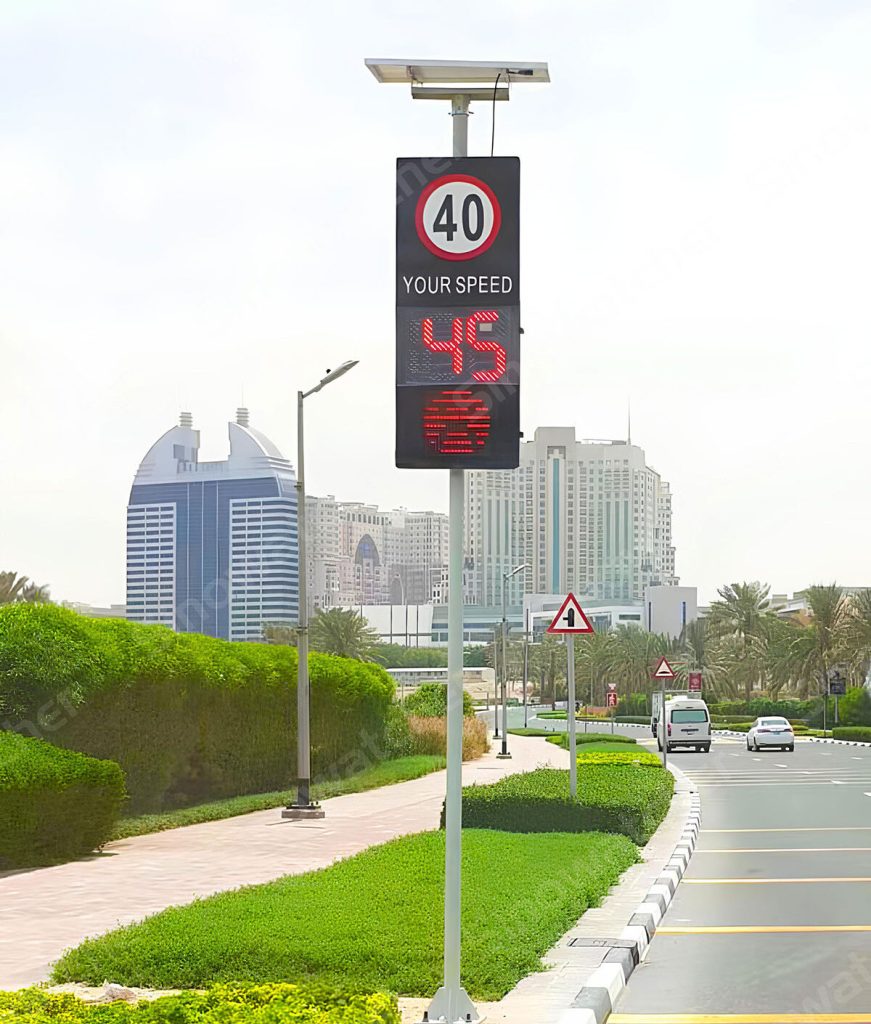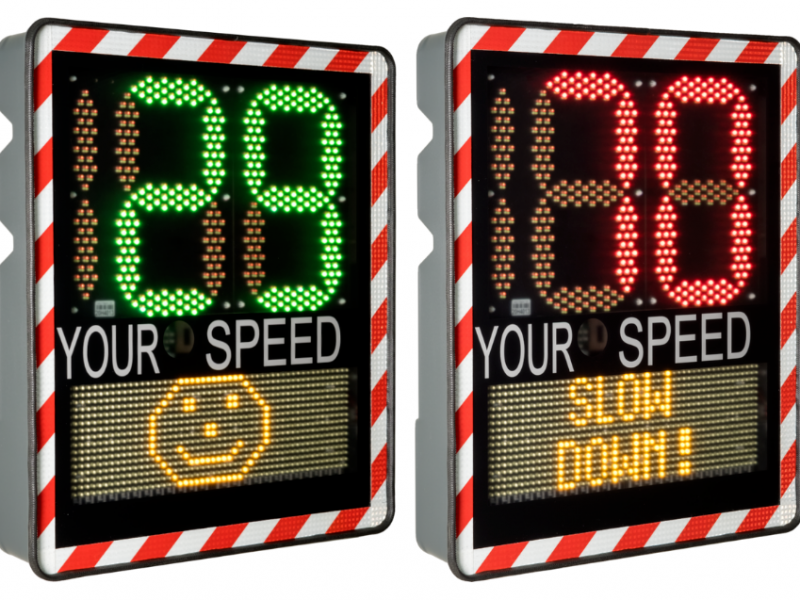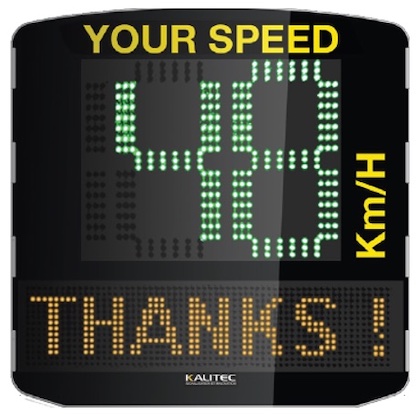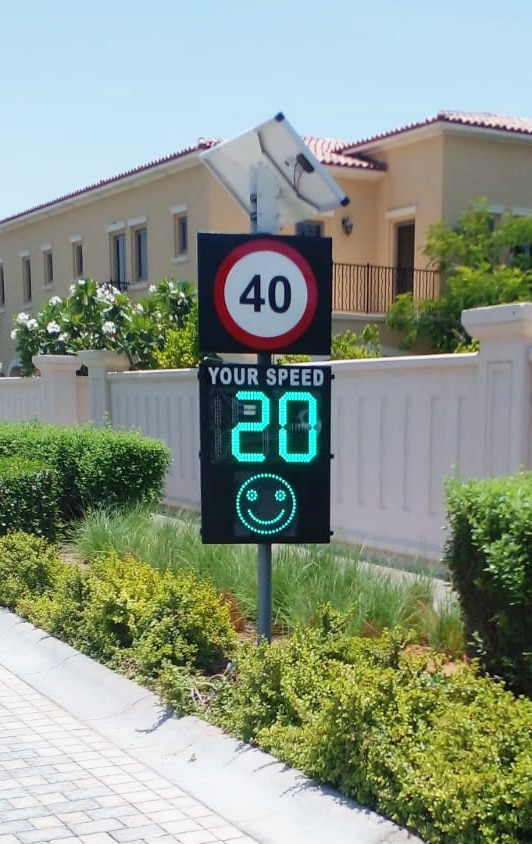AI in Smart Cities: Using Radar Speed Sign Data to Improve Mobility
Data and artificial intelligence (AI) are increasingly determining the progress of urban infrastructure instead of just steel and concrete. As cities across the globe transition into smart cities, the integration of AI in Smart Cities is enabling a data-driven approach to solving long-standing traffic congestion and road safety issues. One underrated yet critical element of this transformation is the radar speed sign.
Speed radar signs are becoming more than just notice displays thanks to their ability to gather real-time speed data and integrate with AI-based mobility algorithms. Radar speed signs with cameras are becoming critical elements in the urban data ecosystem, particularly when paired with camera systems and wireless connectivity. This allows municipalities to evaluate, adjust, and optimize traffic patterns in real time.
What Are Radar Speed Signs and How Do They Work?
One kind of electronic traffic sign that has a Doppler radar sensor installed is a radar speed sign. These signs track the speed of a coming vehicle and show it in real time. When a driver goes over the speed limit, they frequently receive feedback in the form of flashing messages or alerts. High-resolution screens, solar panels for power, and even built-in cameras that record license plate data or vehicle attributes are increasingly features of more recent models.
Initially developed to increase people’s awareness and decrease speeding, these signs are increasingly developing into intelligent gadgets that produce extensive statistics on urban traffic.

The Role of AI in Smart Cities
AI in Smart Cities is the backbone of automation, predictive analytics, and adaptive systems. From traffic lights that respond to congestion to environmental sensors that inform urban planning, AI enables cities to function as integrated, intelligent ecosystems.
When it comes to traffic and mobility, AI thrives on data — and that’s where speed radar signs come in.
Radar speed signs generate data on:
- Real-time vehicle speeds
- Vehicle counts
- Time-stamped traffic patterns
- Behavioral trends (e.g., frequency of speed violations)
- Environmental conditions (in sensor-equipped variants)
This data, when aggregated across thousands of signs and cross-referenced with inputs from CCTV cameras, traffic signals, and GPS devices, fuels urban mobility algorithms that optimize how traffic flows through a city.
From Detection to Prediction: Feeding Urban Mobility Algorithms
1. Data Collection at the Edge
Today’s radar speed signs with cameras act as edge computing nodes. Instead of merely transmitting raw data to central servers, these smart devices can preprocess and filter the information they gather, transmitting only relevant insights.
Examples:
- Filtering out duplicate vehicle data from stationary vehicles.
- Tagging peak-hour data for traffic optimization.
- Anonymizing personal identifiers from camera footage for privacy compliance.
This lean, real-time data collection is crucial for AI algorithms, which thrive on clean, structured datasets for machine learning and real-time inference.
2. Pattern Recognition and Predictive Modeling
Machine learning algorithms ingest radar speed sign data to learn traffic behavior over time. By analyzing patterns such as:
- When and where speeding occurs
- Correlation between weather conditions and traffic speed
- School zone traffic trends
The AI can predict future traffic conditions and suggest adjustments. For example, in areas with frequent morning speed violations, AI can prompt digital message boards or even increase traffic police deployment during those hours.
3. Adaptive Traffic Control Systems
Smart cities equipped with AI-powered adaptive signal control can use data from speed radar signs to adjust traffic lights dynamically.
Case Example:
If multiple radar speed signs with cameras in a corridor detect heavy speeding during low-traffic hours, the system can:
- Increase red-light duration to force natural slowing.
- Notify traffic controllers for possible camera enforcement.
- Adjust signal synchronization to reduce free-flow speeding.

Integrating Radar Speed Sign Data into Urban Infrastructure
1. Smart School Zones and Pedestrian Areas
By using data from radar speed signs with camera modules, city systems can detect violations in school zones and pedestrian-heavy areas. AI can prioritize these zones for:
- Dynamic speed limit reductions
- Real-time alerts to drivers
- Incident detection (e.g., jaywalking or near misses)
This not only improves safety but enables policy makers to justify infrastructure investments using hard data.
2. Policy and Planning with Data-Driven Insights
Urban planners use AI-analyzed radar speed sign data to design better road layouts. Insights into average speed trends can help:
- Redesign intersections
- Add pedestrian crossings
- Create designated bicycle lanes
- Implement traffic calming measures
Moreover, aggregated speed data supports decisions on where to deploy traffic enforcement cameras, which roads require resurfacing, or where to introduce public transport lanes.
Real-Time Alerts and Law Enforcement
1. Immediate Alerts for Speeding Vehicles
Some advanced radar speed signs with camera setups can instantly flag overspeeding vehicles and issue alerts to local enforcement via cloud-connected systems. This reduces reaction time for law enforcement, enabling swift and targeted responses.
2. Automated Ticketing Integration
In smart city environments, the integration of radar signs with AI and license plate recognition can automate speeding fines, subject to legal frameworks. This reduces the burden on human monitoring and improves compliance.
Privacy, Ethics, and Data Governance
While the benefits of AI and smart traffic systems are significant, they must be balanced with privacy and ethical concerns.
Key considerations:
- Anonymizing data collected by radar speed signs with cameras
- Ensuring compliance with data protection laws (like GDPR, or India’s DPDP Act)
- Transparent data use policies by municipalities
- Allowing public access to traffic safety dashboards for accountability
When these systems are implemented ethically, they foster trust and cooperation among citizens.
Global Examples of AI-Driven Speed Sign Systems in Smart Cities
1. Singapore
In Singapore’s smart mobility ecosystem, radar speed signs are part of a broader network that includes AI-powered traffic management centers. Data from these signs is analyzed in real-time to manage peak congestion and guide autonomous vehicles.
2. Dubai
Dubai uses speed radar signs integrated with cloud-based AI systems that generate instant feedback loops. If a school zone shows a spike in speed violations, digital alerts and law enforcement actions are dynamically adjusted.
3. India
Cities like Bangalore and Hyderabad are piloting AI in Smart Cities projects using radar speed signs and connected camera systems to manage their chaotic traffic systems. These data-driven approaches are crucial to managing high-density zones and rapidly growing urban sprawl.

Future Innovations: What’s Next?
1. Vehicle-to-Infrastructure (V2I) Communication
Next-gen radar speed signs will communicate directly with vehicles to alert drivers even before they see the sign. This is critical for autonomous vehicle guidance systems and driver-assistance features.
2. Crowdsourced and Cloud-AI Optimization
Future AI models will ingest data from not only radar speed signs with cameras but also smartphones, GPS apps, ride-sharing platforms, and weather APIs to generate holistic traffic forecasts.
3. AI + Edge + 5G Integration
The introduction of 5G will accelerate real-time data transmission from speed signs, allowing AI models to process and act upon traffic data within milliseconds.
Conclusion: A Small Sign with a Big Role
Radar speed signs are frequently ignored in the grand scheme of AI-powered urban living. However, they are a key component of data-driven traffic management due to their intelligent positioning, real-time feedback, and, more recently, smart communication with cameras and AI.
AI in smart cities is about making little significant changes that make cities safer, smarter, and more sustainable—it’s not only about driverless cars and facial recognition. One car at a time, urban mobility algorithms are able to obtain the real-time data they require to make wise decisions by utilizing the common radar speed sign.

